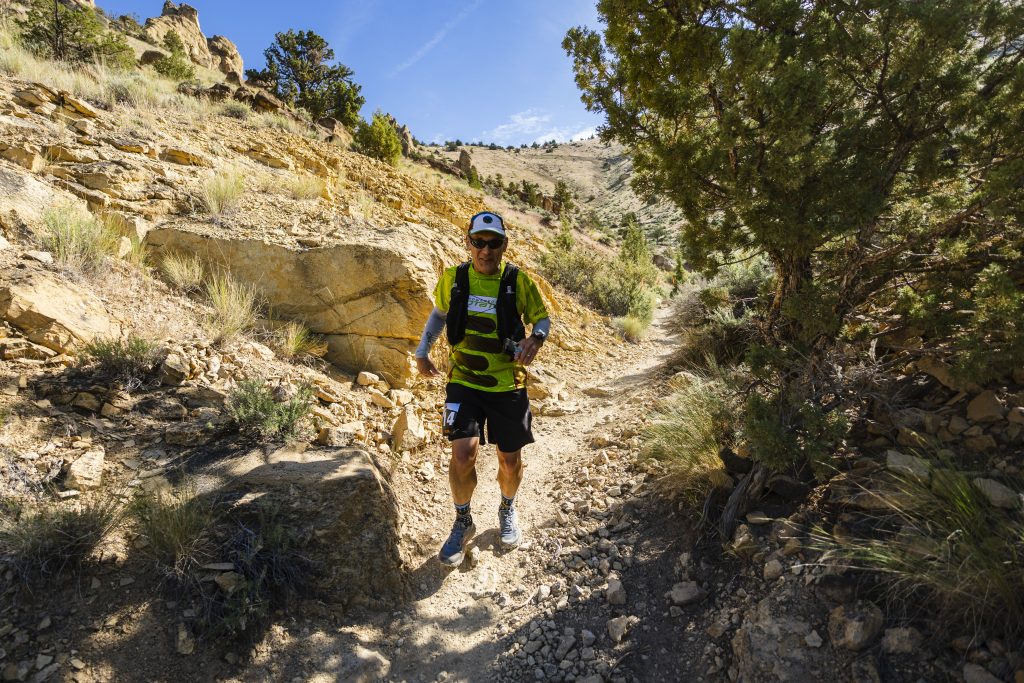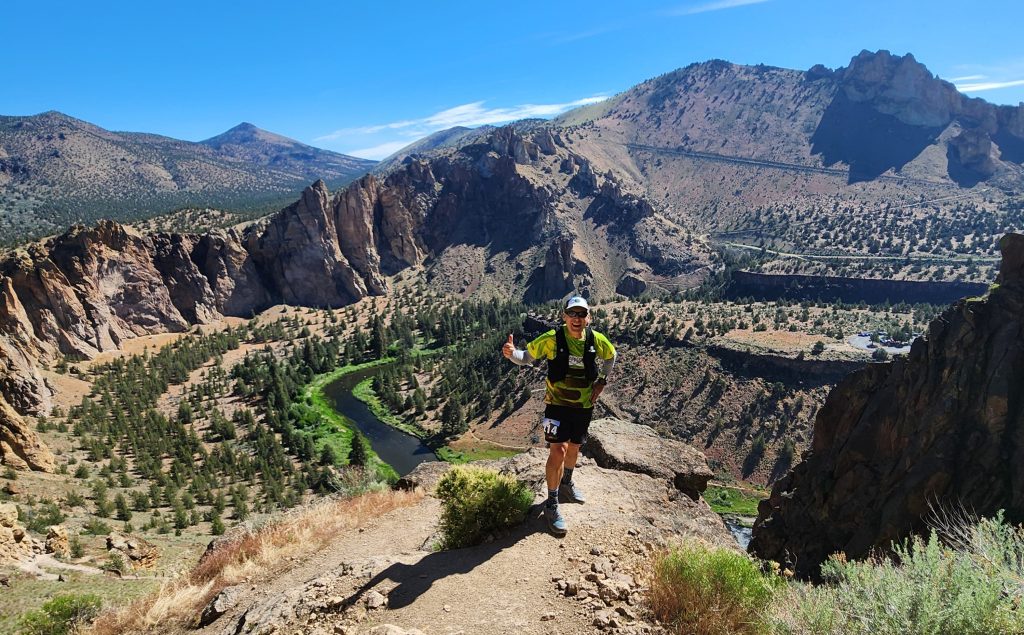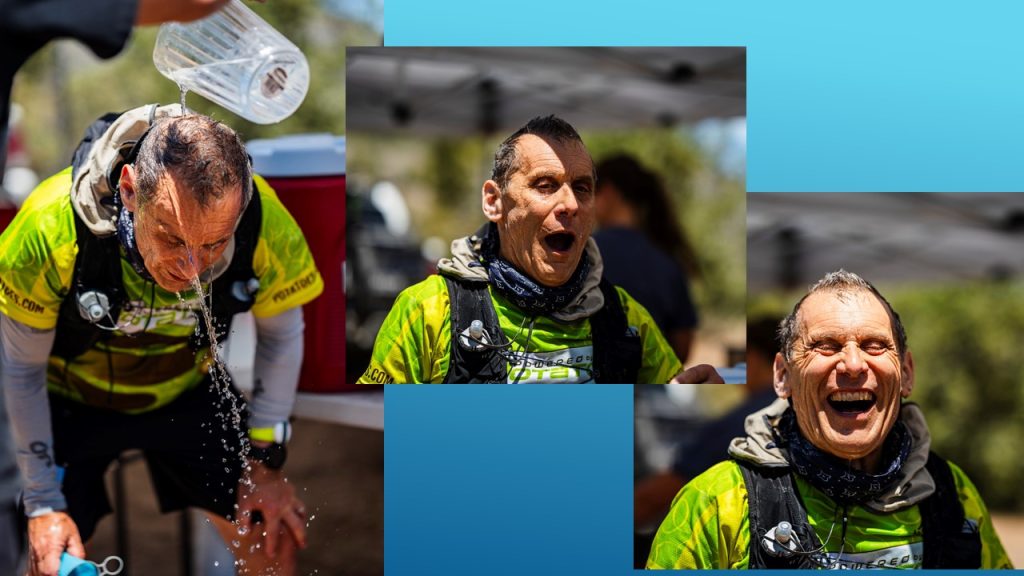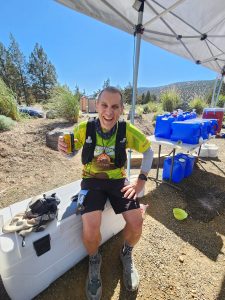Feeling the Heat!- Smith Rock Classic 50K

Be careful what you wish for! After running Eastern Washington’s Badger Mountain 50 mile in pouring rain with 30 mph winds, Cincinnati’s Flying Pig Marathon in 50 degrees and rain, and then a marathon training run on Northwestern Washington’s Whitehorse Trail in monsoonal downpours—I turned to my running partner with exasperation and exclaimed, “I’d rather run in hot and sunny any day over these conditions!” And that’s exactly what I got at Central Oregon’s Smith Rock Classic 50K! And with no shade on the course I got a whole lot of sun—and having not run in 80 degree weather since last September—the 80-plus degrees on race day along with the 4,400 feet of elevation gain made Smith Rock especially challenging.

A lone juniper provides a sliver of shade. photo by James Holk
But I’m always up for a challenge, and the key to racing in the heat and taking on so many other arduous physical activities is to be prepared, be ready to make clothing and nutrition adjustments, and absolutely be smart. Two autumns ago I successfully completed my first 100K race on a mountainous course during a heat wave that reached well into the 90s. One third of the field dropped out and several runners were treated for heat stroke. I made it through the day thanks to my training, willingness to adjust my expectations (I ran a lot slower race, but still made the cutoffs), and making adjustments in clothing, hydrating, and being sure I literally kept my cool. I would take that same attitude into this race—and just like my 100K run—one third of Smith Rock’s participants dropped out. I came in about an hour or so slower than I wanted to—but I successfully finished the race and in relatively good condition!
So what’s the key to running an ultra-race in the heat? While certainly acclimating to heat beforehand helps, I didn’t have that option this spring. It was cooler than normal in the Northwest, and even on spring trips to Ohio, Florida, and Texas I didn’t get any serious heat training. In Texas I was dealing with an artic vortex that brought temperature in the teens. Sheesh! So with no heat training this spring I had to absolutely make sure of two things—and this is true on every race—but especially true on hot days—stay hydrated and don’t overheat. Not only will those two conditions (and it only takes one of them) have the potential to knock you out of the race—but also do some serious damage too—heat stroke can kill you.

What a view from Misery Ridge
So what do I do differently in the heat? Clothing for one. While it may sound counter to logic, I want less exposed skin to the sun. Sure you want to cover up to protect from sunburn, but mostly to thwart overheating. Wearing a singlet and visor is directly exposing you to the sun. When your body produces sweat to cool you off, it’s almost instantly evaporated in the heat causing your body to overheat. I wore my sun sleeves the entire day, and on my head was my trusty Sahara hat that completely covered the sides of my face and my neck. There is a reason (besides cultural) why people in the Middle East wear garments covering their head and neck in the stifling heat. My hat, sleeves, and bandana (more on that coming) kept my sun exposure down.
Now about that bandana—it was used to wrap ice around my neck at each aid station. And I liberally stuffed ice in my hat too—all to fight any chance of overheating. And in tandem with keeping cool is staying hydrated. I started drinking copious amounts of water before the race began and I made sure at every aid station to not only fill my flasks, but to down serious amounts of water and before heading out. A Sports drink is important too to avoid electrolyte depletion and cramping. I started taking electrolytes before the race in both liquid and tablets—and I made sure that the foods I ate before, during and afterwards were rich in potassium. Potassium fuels muscles, and I’ll need plenty of fuel to run 50 kilometers in mountainous terrain in Oregon’s High Desert. Bananas and potatoes are two of the best natural sources of potassium and I have them every race morning and throughout the race at the aid stations. Banana and orange slices as well red potatoes all go down pretty fast and easy when I am on the run. Post-race I usually indulge in potatoes as well although not usually in their healthiest form—but after running an ultra I can lighten up on the diet. Instead of fries I had potato salad after this race and it hit the spot!

Coming back to life!! photos by James Holk
Of course I adjust my pace on hot days too. I try to run faster before it heats up—although this race didn’t give us much of a window with its fairly later start and lack of shade from the start. I adjust my pace in the heat striving for a decent pace without overheating. I did run into a little trouble halfway on a long four mile ascent with no shade. I was getting light headed. I made sure as soon I got to the aid station to immediately cool down. The volunteers there including my friend and veteran ultra-runner Wendy did a great job dousing my head with cold water and stuffing my hat and bandana with ice. They made sure too I was getting rehydrated. After about 15 minutes of recovering (and thinking about the irony of spending lots of time at an aid station at my last ultra trying to warm up and dry out) I was on my way again. I was able to hold a pace for a respectable finishing time. And in this race in which my friend Wendy told me there were many causalities on the course from the heat, all of us who finished did well! I also took pride in seeing that I was the oldest finisher! There were only 3 of us over 60 who completed the race. Heat definitely becomes more of an issue as you get older, another concern we older runners have to address in this challenging but oh so reward world of ultra-running!
But despite the heat, this race conducted by Alpine Running was wonderful. I have always wanted to hike Smith Rock State Park, seeing countless pictures of this amazing geological area on the Crooked River outside of Redmond Oregon. The race also traversed the beautiful Crooked River National Grassland. Smith Rock has long been a climber’s paradise and they were out in full force that day. I think what they do is absolutely insane—and they think the same of what I do! The wildflowers were out in full force too and in an ultra you always have time to stop and shoot some pictures. Snakes were also out! I encountered two rattlesnakes—but they were chill, and one big bull snake stretched out across the trail. That will get your heart rate up—and at mile 20 I needed that!

7 hours 54 minutes after starting-how sweet it is to finish!
I’m set to run a 50 mile race in two weeks in what will be my last ultra-race before my big 100 Miler on July 28th. I’m hoping my body is getting more acclimated to the heat because it will probably be a hot one on both of these upcoming races in mountains and ridges just east of Mount Hood! Adjust and run smart!
Big Thanks to the Washington State Potato Commission for sponsoring me. I am proud to be a member of Team Potato and to showcase the nutritional value and performance enhancement of potatoes as I attempt to run a marathon or ultra-marathon in all 50 states—and train for my first 100 mile run! I’ve got many miles left to go—and lots of potatoes to consume to power me along the way.
